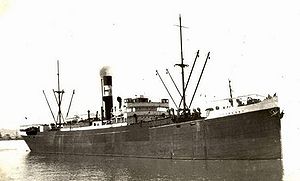SS Scoresby

| |
| Career | |
|---|---|
| Name: | SS Scoresby |
| Operator: | Headlam & Sons, Whitby |
| Builder: | Robert Thompson & Sons Ltd, Bridge Dockyard, Sunderland |
| Completed: | 1923 |
| Fate: | sunk on 17 October 1940 |
| General characteristics | |
| Class and type: | Steam merchant ship |
| Tonnage: | 3,843 tons[vague] |
| Crew: | 39 |
The SS Scoresby was a British steam merchant ship. She was launched in 1923 and was sunk whilst carrying supplies to the UK during the Second World War.
Pre war career
Scoresby was built in the yards of Robert Thompson & Sons Ltd, Bridge Dockyard, Sunderland, being completed in 1923. She entered service with Headlam & Sons, of Whitby and was homeported in the town.
Wartime career and sinking
She had an active wartime career, sailing in numerous local convoys around the British Isles, and twice making trips to and from North America, usually from Halifax, Nova Scotia and Liverpool. Her last crossing to North America came in August 1940, as part of convoy OA-207. She later joined the ill-fated convoy SC-7 for the return voyage. Scoresby sailed from Corner Brook to Sydney, Nova Scotia, Canada, via Francis Harbour, from where the convoy sailed on 5 October 1940, bound for the Clyde. Scoresby carried a cargo of 1,685 cubic fathoms (10,310 m³) of pit props, and was under the command of her master, Lawrence Zebedee Weatherill. She was also the ship of the convoy's vice-commodore. The convoy had only a single escort to start with, the sloop HMS Scarborough. The convoy was located by a wolf pack of U-boats from 16 October, and they quickly overwhelmed the convoy, sinking many of the ships. The Scoresby was spotted and attacked by U-48 at 05.53 hours on 17 October. U-48 had fired three torpedoes at three ships in the convoy, as they passed about 160 miles[vague] (260 km or 300 km) northwest of Rockall. U-48’s commander Heinrich Bleichrodt claimed to have sunk two ships and damaged another, but only the tanker Languedoc and the Scoresby were hit with one torpedo each and sunk. The entire crew successfully abandoned ship, with the master and 38 crew members being picked up by HMS Bluebell and were landed at Gourock on 20 October.
References
- All Wikipedia articles needing clarification
- Wikipedia articles needing clarification from February 2009
- Articles with invalid date parameter in template
- World War II shipwrecks in the Atlantic Ocean
- Ships sunk by German submarines
- Steamships
- World War II merchant ships of the United Kingdom
- Wear-built ships
- 1923 ships
- Maritime incidents in 1940
